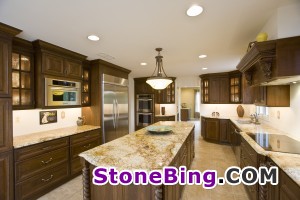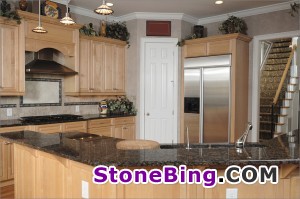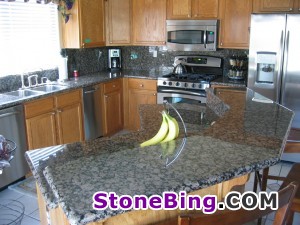For many people, the kitchen is the heart of their home. It is the gathering place where families come together to prepare food, eat meals together, do homework, visit with friends, talk and much more. Due to this centrality and importance of the room/area, many people want their kitchen to be as enjoyable, functional and efficient as possible. When taking on a home improvement project such as remodeling the kitchen or bathrooms, they are often one of the primary features (if not the main one) taken into consideration. While there are many different materials available for kitchen counters, the one that is constantly in highest demand is granite.
There are a number of benefits of granite countertops, including:
Durability
Granite is practically indestructible. There is almost nothing that can be done in the kitchen that will harm the surface of a granite slab. You can set hot pots and pans on it, spill wine on it and even use it as a cutting board without damaging it (as long as it is properly sealed). It resists almost all stains, scratches and heat. It also is completely sanitary (doesn’t hold bacteria) and easy to clean. If maintained annually, it can keep its function and shine for a lifetime.
Style
Its natural beauty and lustre are timeless and attract everyone’s eyes. There are hundreds of different patterns, veins, swirls and colors found in natural granite. Each one has a one-of-a-kind combination of these aspects, so no two counters are alike. This enables you to find one that fits perfectly with the decor and design of your kitchen in addition to being a unique and personal expression of your style and taste. Another benefit is that using granite for kitchen counters is not just a trend. It has always been a popular and sought-after kitchen feature and will continue to be for a long time.

Investment
The cost of using granite for your countertops is not only well worth it in terms of durability, beauty and overall functionality, but it also serves as an investment in your home. Granite is so highly sought-after and preferred that getting it installed adds to the resale value to your home. Many home buyers are actually willing to pay more for a house if it comes with granite counters.
Types of Granite
There are three common types of granite countertops: tiled, modular and slab.
Tiled granite counters are simply made up of granite tiles. The tiles are placed edge to edge and secured with epoxy. The primary advantage of this type is affordability. It is also the most do-it-yourself friendly and many homeowners choose this option and do the work themselves to save a significant amount of money. While tiles still can provide a high quality granite look, the main drawback is that they are more difficult to clean because they create many seams on the surface that can collect dirt and grime.
Modular (prefabricated) granite is the mid-range option and comes in pre-cut “mini-slabs” that come in several standard sizes (12 inches wide on average) and are available in kitchen-ready sizes and shapes. It is more expensive than tiles but cheaper than slab on a per square foot basis. While being considerably more affordable than slab granite, its size limitations cause a number of undesirable seams. Modular granite is also relatively easy to handle and transport, making do-it-yourself installation possible by any determined/motivated individual.

The most expensive (and elegant) option, slab granite is a solid piece of granite that is fabricated and customized off site and must be installed by a professional due to its size, weight and how hard it is to install. They are custom cut to the appropriate shape and width and can be quite large, ranging from 7-9 feet wide and 4-5.5 feet deep. Due to their size, counters made of slab granite usually consist of a single, uniform piece instead of being split up into sections. The increase in price compared to the other options is due to several factors, namely the cost of fabrication, customization and transportation. Custom slabs can be purchased at local stone yards, high-end kitchen & bath stores as well as retail stores including Lowe’s and Home Depot.
Average Cost and What Should Be Included
Granite tiles typically cost around $4 to $19 per square foot or $120 to $570 for 30 square feet of counter space. DIY kits that contain the tiles and backsplashes necessary are available for around $100-200 for each section (eg. 24 inch wide corner piece). Using several kits, the total you should expect to pay for a 30 sq. ft. counter ranges from $500 to $1400. However, these kits do not provide any of the mortar or tools needed to complete the job. To factor these in, add anywhere from $100-$400 depending on what you already have on hand and are able to borrow.
Modular (or prefabricated) granite costs anywhere from $25 to $100 per sq. ft. (for materials only). Based on this, the average-sized kitchen counter is around $750 to $3,000 if you install it yourself. The sections should come already polished, sealed and sporting a standard shaped outer edge. They typically come with matching backsplashes as well.

Slab granite runs about $60-$100 per square foot installed and depends upon the rarity and color of the granite and the edging you choose (among other factors discussed below). Therefore, a completely installed 30 sq. ft. (typical counter size) slab should cost around $1,800-$3,000. This price includes the cost of the slab itself, materials and supplies as well as the labor required, from pre-installation measurements, preparations and adjustments, installation, edging, polishing, sealing and finally cleanup and inspection. Be wary of companies who are offering to install slabs for $30 to $40 per square foot. You typically get what you pay for and sometimes this price does not include any “extras” such as sealing, backsplashes or edging.
There are a number of factors and options that can affect the final price of a countertop installation. The granite itself can cost anywhere from as low as $30 to over $100 per square foot. First of all, it depends on the color, pattern and rarity of the granite you choose. Next, the level of customization and fabrication complexity you choose will have an impact. This includes your choice of thickness (typically around 1 inch or 3 cm), edging treatments (bevel, round over, half bullnose, etc.), backsplashes, custom cuts, sealing, finishing and whether or not you want an undermount sink.
Installation costs vary widely as they depend on the type, experience and quality of the installer (independent, retail store, stone yard or specialty store) and the complexity of the installation required including transportation and handling. Your location also has an effect as areas with a higher cost of living, higher demand and/or lower installer competition will have higher overall costs.
If you’re looking for an alternative to granite countertops, look into getting quartz countertops. They are somewhat cheaper, equally beautiful (depending on who you ask) and are completely maintenance free.
Finding the Right Installer
When looking for a professional contractor to install them, you want someone who is trustworthy, transparent, experienced and easy to work with. Here are a few tips that will help you find the right person for the job:
1. Ask friends and family to refer you to an installer if they have had countertops installed in the past and were satisfied with the work.
2. Shop around. Get at least 3 different installers to bid on your project. Both Lowe’s and Home Depot employ professional contractors and there are independent granite installers as well. This will not only give you a range of prices to choose from, but also help you figure out which prices are abnormally high or low. Each bid should include an itemized list of the estimated materials, extras and labor required. Cheaper is not always better, especially when the money is going toward an upscale kitchen feature such as a granite kitchen counter. Choose a mid-range bid submitted by a reputable contractor.
3. Research online to find out about the installers’ reputations and read customer reviews.
4. Ask for references. Get references for a few previous (similar) jobs from each bidder and contact them directly for feedback. Also ask for pictures and examples of previous work from the installer and maybe even visit their showroom. Ask questions such as: “were you happy with the quality of work?” and “was the project completed in a timely manner?” Also ask if there were any unexpected or “hidden” costs during the project or in the final cost.
5. Ask a lot of questions and take your ideas and concerns into consideration. Countertops can get quite expensive so it is important that you fully understand the cost and quality of the work that will be done and that they understand your expectations and budget. Consider asking about their contractor licenses, insurance coverage, whether they will subcontract any work out and how long the project will take. Purchasing and installing counters can be expensive, but remember that it is an investment in your home. Once installed, you will reap the benefits of the durability, beauty and efficiency of a granite counter for many years to come. The heart of your home will have countertops that are a work of art, fully functional and easy to take care of.







